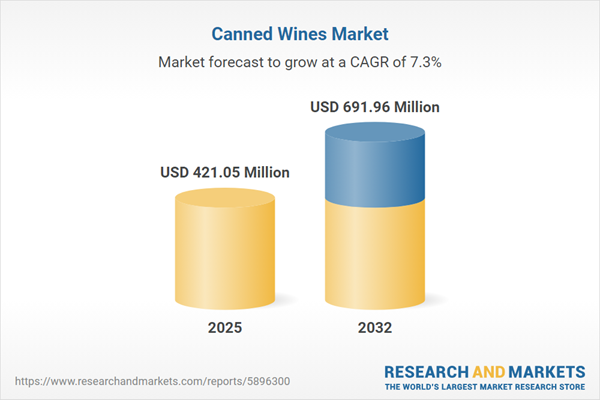Speak directly to the analyst to clarify any post sales queries you may have.
The canned wine market is gaining momentum as a modern beverage category shaped by convenience, sustainability, and evolving consumer preferences. Increasing adoption among new demographics and the integration of digital commerce channels are steering the trajectory of this sector, offering senior decision-makers actionable insights for future growth.
Market Snapshot: Canned Wine Market Size and Outlook
The Canned Wines Market grew from USD 394.46 million in 2024 to USD 421.05 million in 2025. It is expected to continue growing at a CAGR of 7.27%, reaching USD 691.96 million by 2032. Leading industry players are responding to the rising demand for portable, eco-friendly, and innovative beverage solutions, addressing both regional tastes and sustainability imperatives. This expansion signals a clear shift in consumer purchasing habits, supply chain adaptation, and market readiness for agile product development.
Scope & Segmentation
This comprehensive report provides an in-depth review of the canned wine market’s structure, covering critical segmentation parameters and geographic coverage. It identifies current and emerging trends influencing product differentiation and strategic moves.
- Product: Fortified wine, sparkling wine
- Alcohol Content: Low alcohol, non-alcoholic, regular alcohol
- Flavor Innovations: Fruity, herbal, spicy
- Packaging: Multipack, single can, variety pack
- Distribution Channel: Offline, online
- Regional Coverage: Americas (including North and Latin America), Europe, Middle East & Africa, Asia-Pacific
- Company Analysis Includes: AA Badenhorst, Anheuser-Busch InBev SA/NV, Bowl Grabber Ltd., Canned Wine Co., Castel Freres S.A.S., Constellation Brands, Inc., Day Drinking Wines, E. & J. Gallo Winery, Francis Ford Coppola Winery, Graham + Fisk's Wine-In-A-Can, Hidden Sea, Kim Crawford Wines Limited, Kiss of Wine UG, MANCAN LIMITED, McBride Sisters Wine Company, Nomadica, Inc., Original House Wine, Pampelonne Ltd., Precept Wine, Presto Prosecco, Sans Wine Co., Sula Vineyards Pvt. Ltd., The Wine Group LLC, Treasury Wine Estate, Union Wine Company
Key Takeaways
- The primary keyword "canned wine market" signals both dynamic product innovation and broader changes in consumer lifestyle, especially among younger demographics seeking convenience and variety.
- Sustainability initiatives, such as lightweight aluminum cans and improved recycling processes, continue to shape industry practices and brand strategies.
- Digital transformation is redefining consumer engagement, with direct-to-consumer and subscription models fueling loyalty while generating actionable market intelligence.
- Flavor innovation and packaging formats play a pivotal role in brand differentiation, targeting both mainstream and niche segments through diverse product offerings.
- Regional nuances, including urbanization in Asia-Pacific and regulatory frameworks in EMEA, require tailored go-to-market strategies and flexible supply chain responses.
- Collaboration between winemakers and packaging suppliers enhances operational efficiency and shortens product development cycles.
Tariff Impact on Market Dynamics
Recent tariff regulations in the United States have increased the complexity of the canned wine market. Importers are responding by shifting supply chains and strengthening relationships with domestic canning facilities, driving further investment in local production capacity. Adaptive pricing and collaborative partnerships are proven strategies to mitigate cost pressures and preserve consumer demand during periods of regulatory change.
Methodology & Data Sources
Findings draw from qualitative interviews with winemakers, packaging engineers, and retail buyers, alongside field observations at production and retail sites. Secondary research incorporates a review of industry reports, trade papers, and patent data, validated through triangulation of shipment records, export statistics, and retail sales figures.
Why This Report Matters
- Delivers actionable intelligence on product innovation, regional trends, and supply chain optimization crucial for informed market entry or expansion decisions.
- Enables senior leaders to benchmark competitive strategies, assess tariff implications, and capitalize on emerging opportunities in a rapidly evolving beverage sector.
Conclusion
The canned wine category continues to evolve through sustained innovation, consumer-centric engagement, and nimble adaptation to global and regional shifts. Senior decision-makers equipped with robust insights from this report are well-positioned to lead market advancements and realize strategic objectives.
Additional Product Information:
- Purchase of this report includes 1 year online access with quarterly updates.
- This report can be updated on request. Please contact our Customer Experience team using the Ask a Question widget on our website.
Table of Contents
3. Executive Summary
4. Market Overview
7. Cumulative Impact of Artificial Intelligence 2025
Companies Mentioned
The companies profiled in this Canned Wines market report include:- AA Badenhorst
- Anheuser-Busch InBev SA/NV
- Bowl Grabber Ltd.
- Canned Wine Co.
- Castel Freres S.A.S.
- Constellation Brands, Inc.
- Day Drinking Wines
- E. & J. Gallo Winery
- Francis Ford Coppola Winery
- Graham + Fisk's Wine-In-A-Can
- Hidden Sea
- Kim Crawford Wines Limited
- Kiss of Wine UG
- MANCAN LIMITED
- McBride Sisters Wine Company
- Nomadica, Inc.
- Original House Wine
- Pampelonne Ltd.
- Precept Wine
- Presto Prosecco
- Sans Wine Co.
- Sula Vineyards Pvt. Ltd.
- The Wine Group LLC
- Treasury Wine Estate
- Union Wine Company
Table Information
| Report Attribute | Details |
|---|---|
| No. of Pages | 186 |
| Published | November 2025 |
| Forecast Period | 2025 - 2032 |
| Estimated Market Value ( USD | $ 421.05 Million |
| Forecasted Market Value ( USD | $ 691.96 Million |
| Compound Annual Growth Rate | 7.2% |
| Regions Covered | Global |
| No. of Companies Mentioned | 26 |









